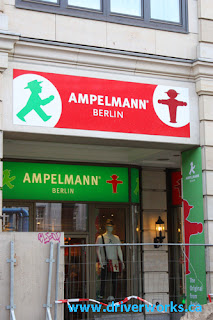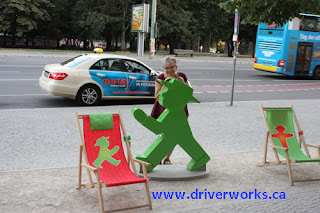Hi. It's the Never Leave Your Wingman book again, and I am reporting to you from this intriguing city that is such a contrast of styles and stories - incredibly modern mixed with remnants of Communism and old-war history. So in case you haven't been following my blogs up to this point - I am the true story of a seven-time cancer survivor in Regina, Saskatchewan, Canada, who dressed in costumes and danced into her chemotherapy treatments alongside her supportive husband - her wingman - when she was fighting Stage IV liver, lung and bone cancers in 2009 and 2010. Her name is Dionne Warner (her husband is Graham Warner), and she is very much alive and well. She still dances into her chemo treatments for her eighth cancer diagnosis - liver cancer again - but that's not what this blog is about today.
As I said, I'm a book and I was written by author/editor/book publisher Deana Driver, and she is the person who usually writes this blog. But this summer, she surprised me and took me in her backpack as she and her husband, whom I call Publisher Al - because that's his name, and he is Deana's husband and business partner in their company DriverWorks Ink ... Oh, wait. Where was I? Oh, yes. I was in Regina, Saskatchewan, when they scooped me up and took me with them to Europe on their once-in-a-lifetime adventure this summer. So I've been blogging about what I (and we) saw and did in Europe.
So here we are in Berlin.
Well, okay, that really wasn't our FIRST view of Berlin, but you gotta admit he's kinda cute. And the German guy beside him wearing Lederhose is also kinda handsome. Ha Ha Ha!
Okay, seriously now. The random parking was something we still weren't quite adjusted to, even after we'd spent several weeks in Europe.
But my author took an immediate liking to these little guys - the 'Walk' and 'Don't Walk' characters that appear on many of Berlin's traffic light stands.
Turns out the little guy is called Ampelmann. He came to life in East Germany and became very popular. His popularity increased even more when there was a move to replace him for more traditional pedestrian 'walk' symbols after the 1990 reunification of Germany. Public outcry ensured that his image is now in Western and Eastern Berlin and merchandise bearing his likeness is extremely popular.
My author thought she would see if she could be Ampelmann.
Um... No.
Berlin was heavily bombed during the Second World War and there are many modern buildings...
...mixed with some more traditional-looking styles. But what is most striking about Berlin is the vibrancy of its people, who are constantly building, rebuilding, and preserving the history of this most historical place.
This chalk artist was representing the scene in front of him - the rebuilding or constant building of his city.
In 1933, the Third Reich burned 20,000 books that came from Humboldt University's library. This made me sad. I had to sit down and think about that for a while.
I was also sad to see the many plaques in the sidewalk outside the university that honoured many professors who died during the war - many in concentration camps.
It lifted my spirits to see this angel...
...and this one.
The Reichstag is Germany's parliament building and features the most incredible glass dome.
Here's Publisher Al and my author on the roof, outside the dome.
This is what we saw inside the dome as we walked up the spiral walkway around the dome. The Reichstag uses solar energy and the dome has a large screen attached to its centre piece which moves with the sun. We enjoyed the audioguide as we walked up to view Berlin from the rooftop.
Berlin is a city of memorials. This is a 2005 art installation of 2,711 gravestone-like concrete pillars to honour and remember the Murdered Jews of Europe.
The pillars are of all shapes and sizes. A walk through these pathways, complete with hills and valleys, fills one with awe, sadness and gratitude.
With this beautiful historic church as a backdrop, these circular displays honour some of Berlin's builders, intellectuals, artists and teachers who died during the Second World War.
My author and I were particularly moved by the memorial on the top here. Else Ury was one of Germany's 'best-known and widely read' children's book authors. 'She was deported to Auschwitz and murdered immediately after her arrival.'
Writing this blog led me and my author to find this wonderful tribute to Else Ury. It made us happy to read about this talented author's life and how she is being remembered.
The most common tourist attractions in Berlin are the Brandenburg Gate...
...Checkpoint Charlie...
...and the Berlin Wall.
We saw several different sections of the Wall which stood from 1961 to 1989, separating West and East Germany. Above was a section at a memorial near Checkpoint Charlie.
Here's a piece of the wall with murals and memorials on it.
Passersby could get their passport stamped here - for a fee - with the original East Berlin visa. We didn't bother. We looked at and read the concrete wall instead.
This section of the wall is still in its original position but is now protected from the 'woodpeckers' - people who came and chipped away sections of the wall for souvenirs and resale after 1989.
And this was our favourite section of the Berlin Wall - the East Side Gallery. It is the biggest remaining stretch of the Wall, covering 1.3 kilometres. With more than 100 paintings by artists all over the world, this International Memorial For Freedom is known as the 'world's longest open air art gallery'.
We'll let the art speak for itself...
I was delighted to see another artist working on his piece. Very cool.
So that's it for this part of our wonderful Europe trip. For now, we'll say goodnight - from beautiful, vibrant, complex Berlin.
I'll see you again soon.




































No comments:
Post a Comment